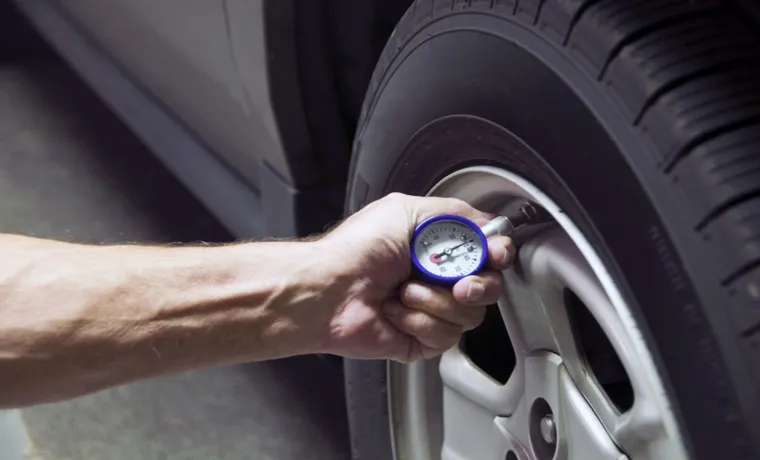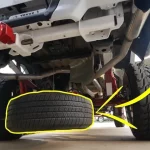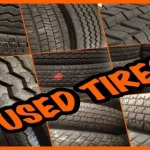Checking tire pressure may seem like a mundane task, but it is crucial for maintaining your Subaru Crosstrek’s performance and safety on the road. With the right tire pressure, you can improve your handling, prevent blowouts, and even extend the lifespan of your tires. But where do you start, and how do you ensure that you’re checking your tire pressure correctly? In this blog post, we’ll walk you through the process step-by-step and provide helpful tips for keeping your Crosstrek’s tires in top condition.
So buckle up and get ready to become a tire pressure expert!
Table of Contents
Why it’s important to check tire pressure
As a Subaru Crosstrek owner, it’s crucial to check your tire pressure on a regular basis. Proper tire pressure not only ensures better fuel efficiency, but it also increases the safety of your vehicle. To check your tire pressure on a Subaru Crosstrek, you’ll need a tire pressure gauge and access to a tire inflator.
The recommended tire pressure for a Crosstrek varies depending on the year and model of the vehicle, so it’s important to check your owner’s manual or the tire information placard on the driver’s side door to make sure you’re inflating to the correct pressure. Simply unscrew the valve cap on each tire, press the tire gauge onto the valve stem, and read the display to determine the current tire pressure. If the pressure is too low, use the tire inflator to add air until the pressure matches the recommended level.
By taking just a few minutes to check your tire pressure, you can save money on gas and keep yourself and your passengers safe while on the road.
Safety: Proper tire pressure reduces risk of accidents
Proper tire pressure is crucial for maintaining safety on the road. Many people don’t realize that failing to maintain the correct tire pressure can lead to serious accidents. Low tire pressure can reduce traction and increase braking distance, making it harder to maneuver the vehicle in an emergency.
It can also cause tire blowouts, which can result in loss of control and dangerous collisions. On the other hand, overinflated tires can affect your car’s stability and cause uneven wear. It’s important to check your tire pressure regularly and keep it at the manufacturer’s recommended level.
By doing so, you can reduce the risk of getting into an accident and keep yourself and other drivers safe on the road. So, the next time you hit the road, make sure to check your tire pressure and stay safe!

Fuel Efficiency: Proper tire pressure can improve gas mileage
Maintaining proper tire pressure is crucial for improving fuel efficiency and saving money at the gas pump. When tires are underinflated, more of their surface area comes into contact with the road, creating resistance and reducing fuel efficiency. In fact, for every 1 psi drop in tire pressure, gas mileage can decrease by up to 0.
3%. That may not sound like much, but over time, it can add up. Not only does maintaining proper tire pressure save money and improve gas mileage, but it also ensures a safer driving experience by improving handling and reducing the risk of blowouts.
So, it’s important to check your tire pressure regularly using a tire pressure gauge and keep them inflated to the manufacturer’s recommended levels. Investing a little time in proper tire maintenance can pay off in a big way in the long run.
Locating the tire pressure monitoring system
If you’re wondering how to check tire pressure on a Subaru Crosstrek, the first step is to locate the tire pressure monitoring system. In the Crosstrek, this system is located in the instrument cluster. You’ll see a small icon that looks like a tire with an exclamation point inside it.
This is your tire pressure warning light, and it will illuminate on your dashboard if your tire pressure is too low. To check your tire pressure, you’ll need to use a tire pressure gauge to measure each tire’s pressure. This can be done at home with a handheld gauge or at any gas station with an air pump.
Remember to check your tire pressure regularly, as having the right pressure can greatly improve your car’s performance and safety.
Step-by-step instructions
If you’re wondering about the location of your tire pressure monitoring system, you’re not alone! This system is essential for maintaining your tires’ optimal pressure, ensuring safety and a longer lifespan for your tires. Luckily, most modern cars have this system installed, and it’s usually located near the wheels. When locating your tire pressure monitoring system, start by checking the owner’s manual that came with your car; it will have detailed instructions with diagrams and illustrations.
You can also look for a symbol that looks like a cross-section of a tire with an exclamation point in the middle on your dashboard; this is a warning light that will indicate when your tire pressure is low. Some tire pressure monitoring systems are located inside the tire, which will require a professional mechanic to access. However, most systems are located near the valve stem; this makes them easy to find and check yourself.
Remember, it’s essential to keep your tire pressure at the recommended levels; you can find this information in your car manual or on a sticker located on the driver’s side door jamb. By checking your tire pressure regularly and maintaining it properly, you’ll ensure your tires’ longevity, save gas, and keep you safe on the road.
If you’re driving a modern car, it most likely comes equipped with a tire pressure monitoring system. The system’s job is to monitor your tire pressure and alert you if any of your tires are under-inflated. However, if you’re not familiar with the system, it can be tough to locate the button to turn it on.
Typically, the button is located on the dashboard, and it might bear an image of a tire with an exclamation mark. Some cars have the button integrated into the infotainment system, but you should refer to your car’s manual to be sure. Once you locate the button, simply press it to activate the system, and you’ll be good to go.
Don’t forget, maintaining adequate tire pressure is essential for your safety. Under-inflated tires can cause accidents, so be sure to check your pressure regularly, even if your car has a monitoring system.
Have you ever found yourself wandering around your car, trying to locate the tire pressure monitoring system? It can be confusing, especially if you are not familiar with your vehicle. The good news is that locating the tire pressure monitoring system is not as complicated as you might think. Most modern cars have this system built-in, and it is usually located near the driver’s seat, either on the dashboard or on the center console.
To access the system, press and hold the button until the screen displays the tire pressure. This process might differ depending on your car’s make and model, but it is generally easy to find and access. By checking your tire pressure regularly, you can ensure your safety on the road and extend the lifespan of your tires.
So, don’t hesitate to find your vehicle’s tire pressure monitoring system and start monitoring your car’s tire pressure today.
What to do if the tire pressure is low
If you’re unsure how to check the tire pressure on your Subaru Crosstrek, don’t worry! It’s a quick and easy process that can help you avoid potential issues on the road. First, locate the recommended tire pressure in your car’s owner’s manual or on the driver’s side door jamb. Using a tire pressure gauge, remove the valve cap from each tire and press the gauge firmly onto the valve stem.
The gauge should give you a reading, which you can compare to the recommended pressure. If the pressure is low, use an air compressor or visit a gas station to fill the tire(s) to the appropriate level. Remember to replace the valve caps when you’re finished.
Regularly checking your Subaru Crosstrek’s tire pressure can help improve fuel efficiency and ensure a safer driving experience.
Check the recommended tire pressure for your Crosstrek
When it comes to maintaining your Subaru Crosstrek, checking your tire pressure is essential. It’s important to know the recommended tire pressure for your Crosstrek, which you can find in your owner’s manual or on the sticker inside the driver’s side door jamb. Keeping your tire pressure at the correct level has many benefits, such as improving fuel efficiency, extending tire life, and maintaining proper handling.
If you notice that your tire pressure is low, don’t ignore it. Driving on underinflated tires can lead to poor vehicle performance, tire damage, and even accidents. Instead, inflate your tires to the specified pressure level as soon as possible.
If adding air doesn’t solve the problem, there may be a puncture or leak in your tire that needs to be repaired. In that case, it’s best to take your vehicle to a professional mechanic for evaluation. By taking care of your tire pressure, you’ll enjoy a safer and more comfortable ride in your Crosstrek.
Use a tire pressure gauge to measure the tire pressure
If you’re driving and your car starts to feel a bit off, especially when turning, it may be because your tire pressure is low. To check if your tire pressure is low, the best thing to do is to use a tire pressure gauge to get an accurate measurement. Simply unscrew the valve cap on your tire, attach the tire pressure gauge to the valve stem, and press down until you get a reading.
If the reading is lower than it should be, don’t worry. It’s a quick and easy fix. You can simply add air to the affected tire(s) until they reach the correct pressure.
This is important because driving on low tire pressure can cause damage to the tire, reducing its lifespan and performance, and even affecting your fuel efficiency. So, always make sure that your tire pressure is within specification, and you’ll have a smoother and safer ride.
Inflate the tire to the recommended pressure if needed
Low tire pressure can be a nuisance, especially if you’re in a hurry to get somewhere. It’s important to address the issue as soon as possible to avoid any potential safety hazards. First, use a tire pressure gauge to check the current pressure.
If the pressure is lower than the recommended amount for your vehicle, you’ll need to inflate the tire. You can do this at a gas station or with a portable air compressor at home. Be sure to check the recommended tire pressure for your vehicle in the owner’s manual or on the tire itself.
Over-inflating the tire can also be dangerous, so make sure you don’t go over the recommended amount. Remember, keeping your tires properly inflated not only helps with safety, but it also prolongs the life of your tires and can save you money in the long run.
Conclusion
In conclusion, properly checking the tire pressure on your Subaru Crosstrek is essential to ensure a smooth and safe ride. Not only will it increase fuel efficiency and longevity of your tires, but it will also prevent any blowouts or other tire-related issues. So, don’t be deflated about the process – just follow our simple steps and you’ll be sure to keep your Crosstrek rolling in style!”
Regularly checking tire pressure can improve safety and save money on gas.
Regularly checking the tire pressure of your vehicle is essential for both your safety and wallet. Low tire pressure can lead to decreased fuel efficiency and increased wear and tear on your tires, which can result in expensive repairs. But what should you do if you find that your tire pressure is low? Firstly, locate your vehicle’s manual to determine the proper tire pressure for your specific make and model.
Next, inflate the tire to the recommended pressure level, using a tire pressure gauge to ensure accuracy. Lastly, avoid over-inflating your tires, as overly inflated tires can lead to a bumpy ride and decreased stability on the road. By regularly checking and maintaining the tire pressure of your vehicle, you can ensure a safe and smooth driving experience while also saving money on gas and repairs.
So, make it a habit to check your tire pressure at least once a month or before embarking on a long road trip. Trust me; your tires and wallet will thank you in the long run.
FAQs
What is the recommended tire pressure for a Subaru Crosstrek?
The recommended tire pressure for a Subaru Crosstrek is 32 psi.
How often should I check the tire pressure on my Subaru Crosstrek?
It is recommended to check the tire pressure on your Subaru Crosstrek at least once a month.
Why is it important to check the tire pressure on a Subaru Crosstrek?
Proper tire pressure ensures the best handling, fuel efficiency, and tire life. It also maximizes safety on the road.
Can I use any tire pressure gauge to check my Subaru Crosstrek’s tire pressure?
Yes, any accurate tire pressure gauge can be used to check the tire pressure on your Subaru Crosstrek.
Is it necessary to check tire pressure when the tires are cold?
Yes, it is recommended to check tire pressure when the tires are cold, before driving for an accurate reading.
How do I inflate my Subaru Crosstrek’s tires to the recommended pressure?
You can inflate your Subaru Crosstrek’s tires to the recommended pressure using an air compressor or by stopping at a gas station with an air pump.
Can overinflated or underinflated tires on my Subaru Crosstrek cause damage?
Yes, overinflated or underinflated tires on your Subaru Crosstrek can cause damage to the tires, decrease fuel efficiency, and affect overall vehicle performance.



